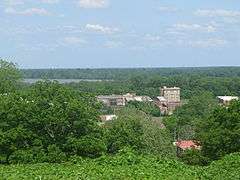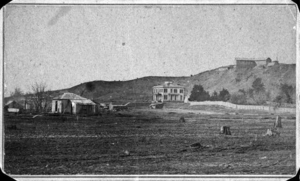Battle of Helena
| ||||||||||||||||||||||||||||||||||||
The Battle of Helena was a land battle of the American Civil War fought on July 4, 1863, at Helena, Arkansas. The battle was a Confederate attempt to relieve pressure on the besieged city of Vicksburg.[1] The victory secured eastern Arkansas for the United States.
Prelude
Lieutenant-General Theophilus Holmes, commander of the District of Arkansas, planned a coordinated attack from three sides on the formidable Federal fortifications surrounding Helena in order to relieve pressure on Vicksburg and to prevent Helena being used as a base to attack further into Arkansas. Holmes wrote to General Kirby Smith, commander of the Trans-Mississippi Department, and received permission to attack Helena.
Infantry under Major-General Sterling Price and cavalry under Brigadier-General John Marmaduke would move from Jacksonport to the vicinity of Helena. Price and Marmaduke would meet up with infantry out of Little Rock, under Brigadier-General James Fagan. Holmes, accompanied by Arkansas Governor Harris Flanagin, travelled to Helena to take personal command of the attack.
Major-General Benjamin Prentiss, in command of the District of Eastern Arkansas, was headquartered at Helena with approximately 20,000 troops. Brigadier-General Frederick Salomon commanded a division from 13th Corps and had been placed in charge of the forces manning the defenses of Helena, a Mississippi River port town at the terminus of Crowley's Ridge and ringed by steep hills cut by heavily thicketed ravines. Four artillery batteries with breastworks and rifle pits were placed in a semicircle around the town. In addition, the USS Tyler, a "timber-clad" gunboat was assigned to support Prentiss.[2]
Prentiss received word that an attack was in the works and actively worked to slow the movement of Confederate forces by felling trees. Helena itself was overcrowded with federal troops and was suffering from housing shortages and poor health and sanitation facilities. Occupying soldiers dubbed the town "Hell-in Arkansas".[3] Just prior to the battle, a large number of troops were transferred to Vicksburg to strengthen the siege around that city. This transfer left only about 4,000 Union soldiers to protect the Federal enclave at Helena.
Opposing forces
Union
Confederate
Battle
Holmes planned for a dawn attack with Marmaduke's 1,700 dismounted cavalry attacking fortified Rightor Hill northwest of the town and capturing the artillery battery stationed there. Fagan's 1,300 men were assigned to capture Hindman's Hill southwest of the city. Brigadier-General Lucius Walker was assigned the task of guarding Marmaduke's flank and preventing Union reinforcements from reaching Rightor Hill. The main attack however, would take place in the center with Sterling Price's 3,100 men seizing Graveyard Hill and the battery protecting it.
Marmaduke's assault ran into trouble quickly and began taking artillery and small arms fire from his left flank. Walker was supposed to intervene for Marmaduke, but failed to come to his aid out of concern for his own exposed position. Walker's failure would eventually lead to bad blood between Marmaduke and Walker that would end in a bloody duel during the campaign for Little Rock.[4] The southwest and center elements of the Confederate attack also suffered from failed communications and misinterpreted orders. Fagan and Price failed to coordinate their attacks due to Holmes' vague order to "attack at daylight". Price interpreted this order to mean an attack at sunrise and Fagan interpreted it to mean an attack at first light.
Fagan was surprised to find his attack on Hindman Hill was opposed by artillery fire from Graveyard Hill. Fagan had expected Price to be engaged already with that battery. Fagan's artillery had not been able to reach the battlefield because of felled trees blocking the road. Fagan had no artillery available to silence the Federal guns and had no choice but to order his troops to try to take the hill while under artillery fire. Fagan's men reached the summit of the hill and managed to seize the outer fortifications but were pinned down just short of the summit by the two Union batteries.[5]
Price's assault on the center of the Union lines did not commence for almost an hour after Fagan's attack began. Price's men charged the Federal lines but were repulsed by concentrated artillery fire from the batteries and the USS Tyler. Price's Confederates made two more desperate charges before successfully capturing the guns on Graveyard Hill. Price attempted to turn the guns on the remaining Federals but found that the guns had been successfully disabled before their capture.[6]
The Confederates had achieved some success despite the miscommunications. Fagan held most of the fortifications to the southwest and Price held the high ground in the center of the Union lines.[2] Holmes arrived on Graveyard Hill and failed to press his advantage home. Holmes was seemingly unable to decide if he should support Marmaduke on his left flank, Fagan on his right flank, or press his advantage in the center and instead issued a series of confusing orders that led to partial measures which failed to turn the tide in any of the three positions.
The exposed Confederates were targeted by every remaining gun on the battlefield as well as the heavy guns of the Tyler. By 10:30 Holmes realized that his position had deteriorated and that he could make no further headway. A general retreat was ordered, and the attack on the Union base had failed.
Aftermath

The Battle of Helena left 239 Union and 1,614 Confederate casualties.[7] No longer threatened, Helena became an important Union enclave on the Mississippi River and would become the base for the successful campaign to seize Little Rock, Arkansas, later in the year.[1] The four battery sites defending Helena have been listed on the National Register of Historic Places, and Battery C, the battery captured by Confederate forces on Graveyard Hill, is now a city park.
See also
Notes
- 1 2 National Park Service battle description
- 1 2 historyofwar.org
- ↑ Encyclopedia of Arkansas
- ↑ BATTERY A SITE, BATTLE OF HELENA, HELENA, PHILLIPS COUNTY, Arkansas Historic Preservation Program, Accessed August 22, 2013
- ↑ United States War Dept.. The War of the Rebellion: A Compilation of the Official Records of the Union And Confederate Armies. Series 1, Volume 22, In Two Parts. Part 1, Reports., Book, 1888; digital images, (http://texashistory.unt.edu/ark:/67531/metapth154600/ : accessed August 24, 2013), University of North Texas Libraries, The Portal to Texas History, http://texashistory.unt.edu; crediting UNT Libraries Government Documents Department, Denton, Texas.
- ↑ United States. War Dept.. The War of the Rebellion: A Compilation of the Official Records of the Union And Confederate Armies. Series 1, Volume 22, In Two Parts. Part 1, Reports., Book, 1888; digital images, (http://texashistory.unt.edu/ark:/67531/metapth154600/ : accessed August 24, 2013), University of North Texas Libraries, The Portal to Texas History, http://texashistory.unt.edu; crediting UNT Libraries Government Documents Department, Denton, Texas.
- ↑ Bearss, "Battle of Helena, July 4, 1863", AHQ, pp. 290,291.
References
- Bearss, Edwin C. "The Battle of Helena, July 4, 1863", Arkansas Historical Quarterly, Autumn, 1961, Vol. 20.
Further reading
- Castel, Albert (1993) [1st pub. 1968]. General Sterling Price and the Civil War in the West (Louisiana pbk. ed.). Baton Rouge; London: Louisiana State University Press. ISBN 0-8071-1854-0. LCCN 68-21804.
External links
| Wikisource has the text of an 1879 American Cyclopædia article about Battle of Helena. |
- Battle of Helena at the American Battlefield Protection Program
- Battle of Helena at the Encyclopedia of Arkansas History & Culture

